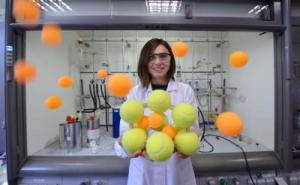Jan 25 2014
In common perception, carbon dioxide is just a greenhouse gas, one of the major environmental problems of mankind. For Warsaw chemists CO2 became, however, something else: a key element of reactions allowing for creation of nanomaterials with unprecedented properties.
 Yellow tennis balls symbolise crystal lattice of the microporous material resulting from self-assembly of nanoclusters. Orange balls imitate gas molecules that can adsorb in this material. The presentation is performed by Katarzyna So³tys, a doctoral student from the Institute of Physical Chemistry of the Polish Academy of Sciences in Warsaw. Credit: IPC PAS, Grzegorz Krzy¿ewski
Yellow tennis balls symbolise crystal lattice of the microporous material resulting from self-assembly of nanoclusters. Orange balls imitate gas molecules that can adsorb in this material. The presentation is performed by Katarzyna So³tys, a doctoral student from the Institute of Physical Chemistry of the Polish Academy of Sciences in Warsaw. Credit: IPC PAS, Grzegorz Krzy¿ewski
In reaction with carbon dioxide, appropriately designed chemicals allowed researchers from the Institute of Physical Chemistry of the Polish Academy of Sciences (IPC PAS) in Warsaw and the Faculty of Chemistry, Warsaw University of Technology, (WUT) for production of unprecedented nanomaterials. The novel materials are highly porous, and in their class they show the most extended, and so the largest surface area, which is of key importance for the envisaged use. Prospective applications include storage of energetically important gases, catalysis or sensing devices. Moreover, microporous fluorescent materials obtained using CO2 emit light with quantum yield significantly higher than those of classical materials used in OLEDs.
"Our research is not confined to fabrication of materials. Its particular importance comes from the fact that it opens a new synthetic route to metal carbonate and metal oxide based nanomaterials, the route where carbon dioxide plays a key role", notices Prof. Janusz Lewiński (IPC PAS, WUT).
The papers reporting accomplishments of Prof. Lewiński's group, achieved in cooperation with Cambridge University and University of Nottingham, were published, i.a., by prestigious chemical journals "Angewandte Chemie" and "Chemical Communications".
Carbon dioxide (CO2) is a natural component of Earth's atmosphere. It is the most abundant carbon-based building block, and is involved in the synthesis of glucose, an energy carrier and building unit of paramount importance for living organisms.
"Carbon dioxide has been for years used in industrial synthesis of polymers. On the other hand, there has been very few research papers reporting fabrication of inorganic functional materials using CO2", says Kamil Sokołowski, a doctoral student in IPC PAS.
Prof. Lewiński's group has shown that appropriately designed precursor compounds in reaction with carbon dioxide lead to fabrication of a microporous material (with pore diameters below 2 nm) resulting from self-assembly of luminescent nanoclusters. Novel microporous material, composed of building blocks with zinc carbonate core encapsulated in appropriately designed organic shell (hydroxyquinoline ligands), is highly luminescent, with photoluminescence quantum yield significantly higher than those of classical fluorescent compounds used in state-of-the-art OLEDs.
"Using carbon dioxide as a building block we were able to construct a highly porous and really highly luminescent material. Can it be used for construction of luminescent diodes or sensing devices? The discovery is new, the research work on the novel material is in progress, but we are deeply convinced that the answer is: yes", says Sokołowski.
Already now it can be said that the novel material enjoys considerable interest. Polish and international patent applications were filed for the invention and the implementation work in cooperation with a joint venture company is in progress.
The design of precursors was inspired by nature, in particular by the binding of carbon dioxide in enzymatic systems of carbonic anhydrase, an enzyme responsible for fast metabolism of CO2 in human body. Effective enzyme activity is based on its active centre, where a hydroxyzinc (ZnOH) type reaction system is located.
"A hydroxyzinc reaction system occurs also in molecules of alkylzinc compounds, designed by us and used for fixation of carbon dioxide", explains Sokołowski and continues: "These compounds are of particular interest for us, because in addition to hydroxyl group they contain also a reactive metal-carbon bond. It means that both the first and the second reaction system can participate in consecutive chemical transformations of such precursors".
The research related to the chemistry of alkylhydroxyzinc compounds has an over 150 years of history and its roots are directly connected to the birth of organometallic chemistry. It was, however, only in 2011 and 2012 when Prof. Lewiński's group has presented the first examples of stable alkylhydroxyzinc compounds obtained as a result of rationally designed synthesis.
The strategy for materials synthesis using carbon dioxide and appropriate alkylhydroxyzinc precursors, discovered by the researchers from Warsaw, seems to be a versatile tool for production of various functional materials. Depending on the composition of the reagents and the process conditions, a mesoporous material (with pore diameter from 2 to 50 nm) composed of zinc carbonate nanoparticles or multinuclear zinc nanocapsules for prospective applications in supramolecular chemistry can be obtained in addition to the material described above.
Further research of Prof. Lewiński's group has shown that the mesoporous materials based on ZnCO3-nanoparticles can be transformed into zinc oxide (ZnO) aerogels. Mesoporous materials made of ZnO nanoparticles with extended surface can be used as catalytic fillings, allowing for and accelerating reactions of various gaseous reagents. Other potential applications are related to semiconducting properties of zinc oxide. That's why the novel materials can be used in future in photovoltaic cells or as a major component of semiconductor sensing devices.
Source: http://www.ichf.edu.pl/